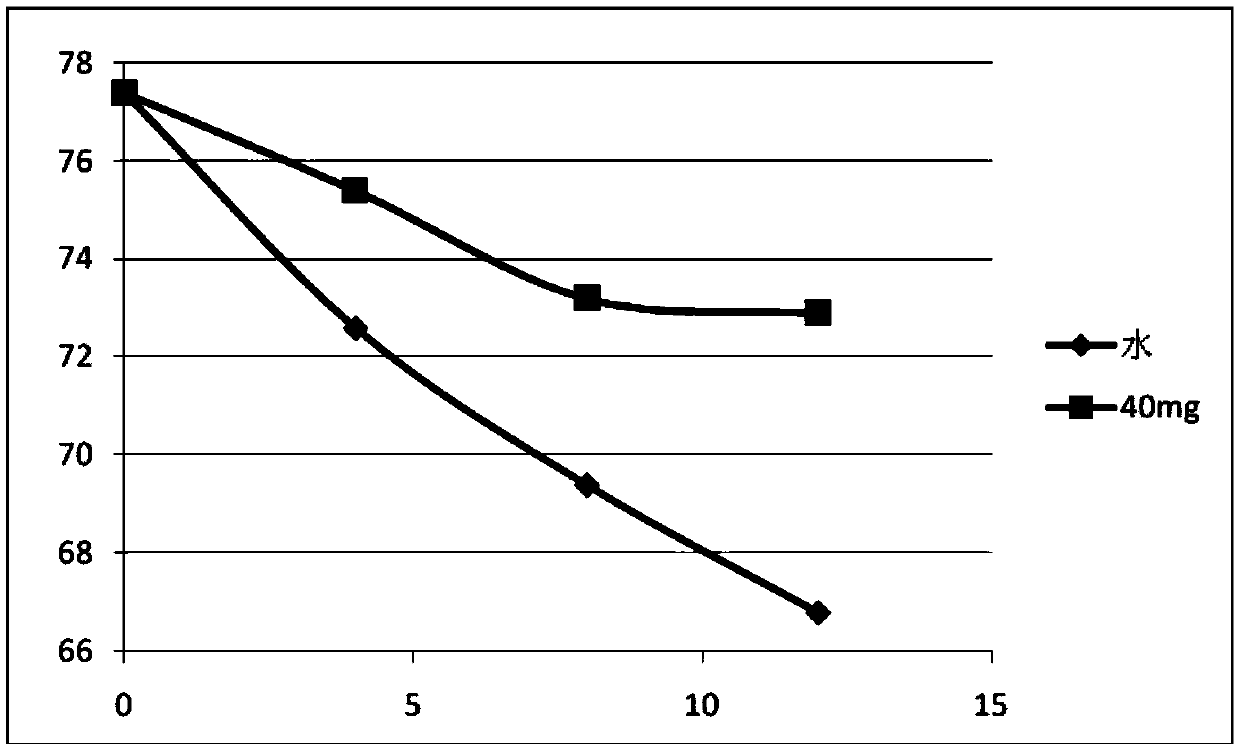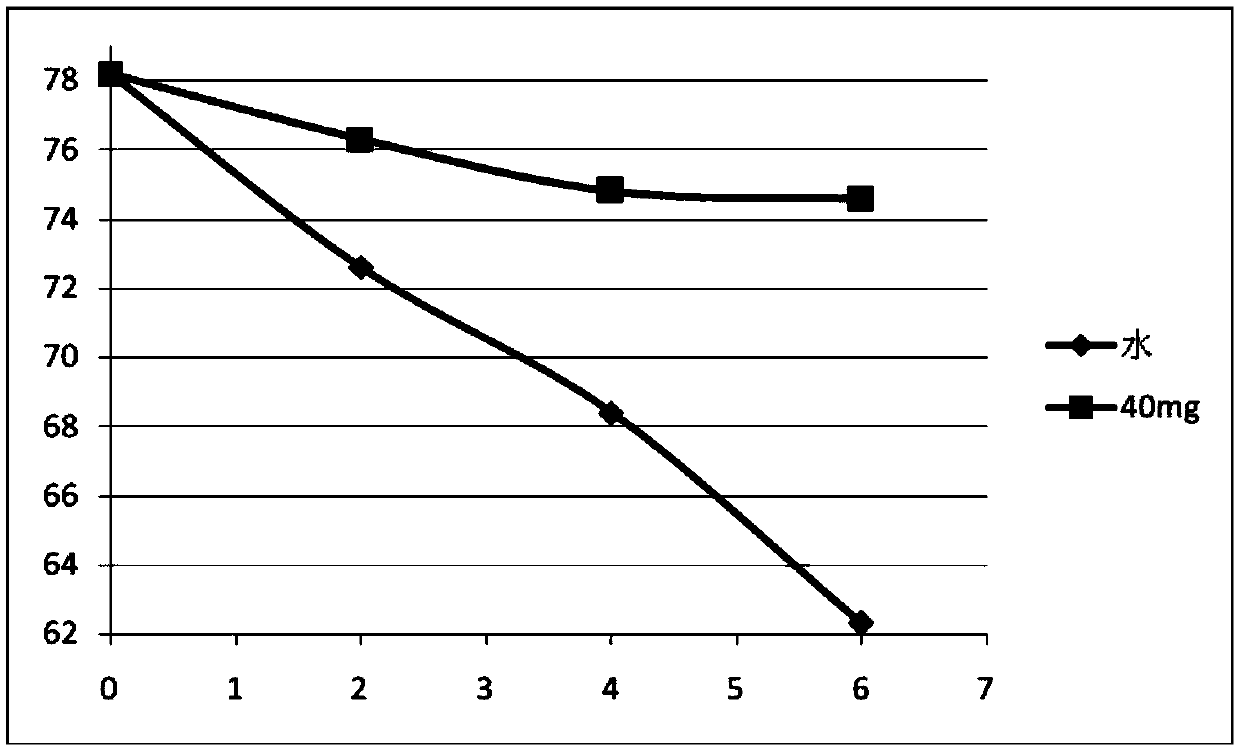A green preparation method of bihobs and its application in the field of anti-corrosion and fresh-keeping
A preservative and food antiseptic technology, applied in application, mercaptan preparation, sulfide preparation, etc., can solve the problems of many side reactions, undisclosed process data and reaction results, difficult source of raw materials, etc., and achieve high efficiency and good anti-corrosion The effect of browning
- Summary
- Abstract
- Description
- Claims
- Application Information
AI Technical Summary
Problems solved by technology
Method used
Image
Examples
preparation example 1
[0057] Preparation Example 1 The preparation of p-hydroxybenzyl sodium thiosulfate
[0058] Put 2.50g (20.16mmol) of p-hydroxybenzyl alcohol, 4.00g (25.3mmol) of sodium thiosulfate, and 3.0g of acetic acid into a reaction flask, add 60ml of water and stir to dissolve. Heat to 90°C, keep at 85-95°C for 4 hours, cool to 40°C, filter, let the filtrate naturally cool to room temperature, then crystallize in the refrigerator overnight, filter with suction, filter out the crystals, dry to obtain p-hydroxybenzoic acid Sodium thiosulfate 3.62g.
[0059] 1 H-NMR (400MHz, D 2 O) δ: 4.17 (s, 2H), 6.75 (d, 2H, J = 8.6), 7.20 (d, 2H, J = 8.6).
[0060] Elemental analysis [experimental value (theoretical value)]: C: 34.74 (34.71); H: 2.86 (2.91); S: 26.43 (26.47).
preparation example 2
[0061] The preparation of preparation example 2 p-hydroxybenzyl potassium thiosulfate
[0062] Put 2.50 g (20.16 mmol) of p-hydroxybenzyl alcohol, 4.82 g (25.3 mmol) of potassium thiosulfate, and 3.0 g of acetic acid into a reaction flask, add 60 ml of water, and stir to dissolve. Heat to 90°C, keep at 85-95°C for 4 hours, cool to 40°C, filter, let the filtrate naturally cool to room temperature, then crystallize in the refrigerator overnight, filter with suction, filter out the crystals, dry to obtain p-hydroxybenzoic acid Potassium thiosulfate 4.21g.
[0063] 1 H-NMR (400MHz, D 2 O) δ: 4.17 (s, 2H), 6.75 (d, 2H, J = 8.6), 7.20 (d, 2H, J = 8.6).
[0064] Elemental analysis [experimental value (theoretical value)]: C: 32.62 (32.54); H: 2.65 (2.73); S: 24.85 (24.82).
preparation example 3
[0065] The preparation of preparation example 3 p-hydroxybenzyl ammonium thiosulfate
[0066] Put 2.50 g (20.16 mmol) of p-hydroxybenzyl alcohol, 3.75 g (25.3 mmol) of ammonium thiosulfate, and 3.0 g of acetic acid into a reaction flask, add 60 ml of water, and stir to dissolve. Heat to 90°C, keep at 85-95°C for 4 hours, cool to 40°C, filter, let the filtrate naturally cool to room temperature, then crystallize in the refrigerator overnight, filter with suction, filter out the crystals, dry to obtain p-hydroxybenzoic acid Ammonium thiosulfate 2.89g.
[0067] 1 H-NMR (400MHz, D 2 O) δ: 4.17 (s, 2H), 6.75 (d, 2H, J = 8.6), 7.20 (d, 2H, J = 8.6).
[0068] Elemental analysis [experimental value (theoretical value)]: C: 35.51 (35.43); H: 4.61 (4.67); N: 5.94 (5.90); S: 27.07 (27.03).
PUM
| Property | Measurement | Unit |
|---|---|---|
| absorbance | aaaaa | aaaaa |
| absorbance | aaaaa | aaaaa |
| absorbance | aaaaa | aaaaa |
Abstract
Description
Claims
Application Information
 Login to View More
Login to View More - R&D
- Intellectual Property
- Life Sciences
- Materials
- Tech Scout
- Unparalleled Data Quality
- Higher Quality Content
- 60% Fewer Hallucinations
Browse by: Latest US Patents, China's latest patents, Technical Efficacy Thesaurus, Application Domain, Technology Topic, Popular Technical Reports.
© 2025 PatSnap. All rights reserved.Legal|Privacy policy|Modern Slavery Act Transparency Statement|Sitemap|About US| Contact US: help@patsnap.com



